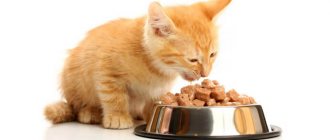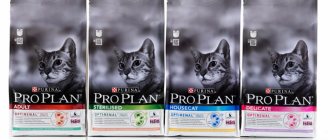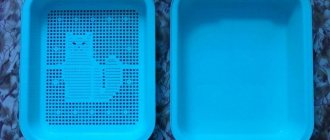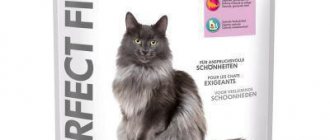Pain in cats is always difficult to diagnose. They are very good at hiding pain; often their gait practically does not change in case of any limb injuries. Therefore, it is important to understand that if you see without a special examination that a cat’s paw hurts, or is limping, or does not use it when walking, this most often indicates serious problems and very severe pain. Although there are exceptions. Some cats, on the contrary, with pain syndrome, react excessively to any touch; for example, they may not allow touching their stomach, back and paws, although only one thing hurts.
When a cat cannot do without painkillers or injections
A cat, like any living creature, experiences pain. The reasons may be different, but pain can only be relieved with the help of painkillers. Another thing is what medications to give the cat in each specific case.
When to relieve pain
Painkillers are used only in cases where the animal is really in pain. For example:
- surgery and postoperative period;
- serious injuries accompanied by fractures, dislocations, ligament ruptures, damage to internal organs, severe bruises;
- inflammatory processes in the cat’s body, including otitis media, pancreatitis, inflammation of the genitourinary system;
- colic;
- toothache;
- peritonitis;
- oncological diseases.
At the same time, under no circumstances should you “prescribe” a cat this or that medicine on your own. In each case, consultation with a veterinarian is necessary.
You can tell if your pet is in pain by the following signs:
- Behavior change. The cat becomes nervous, aggressive, and anxious. At the same time, apathy and lethargy are observed. The animal avoids communication. There may be cases of bowel movement past the potty.
- A pitiful meow occurs when a cat is in severe pain.
- Loss of appetite.
- Atypical poses.
- Physical changes - increased heart rate, rapid and intermittent breathing.
If you notice at least one of the above beacons, immediately take the animal to a veterinary hospital.
Choice of drug
There are 2 main types of painkillers:
- Narcotic.
- Non-steroidal.
The former belong to the category of opioids. They have a pronounced analgesic effect, which occurs almost instantly, since drugs of this type act directly on the central part of the nervous system. Additional effects are hypnotic and sedative.
However, extreme caution must be used with opioids. They are insidious and addictive. In addition, such strong drugs simply by definition cannot be safe. And very often their use causes a number of negative consequences.
Non-steroidal drugs are considered much more gentle. They are not addictive and in most cases have an additional therapeutic effect.
But non-steroidal painkillers cannot cope with severe pain. The maximum they can do is to alleviate the condition of an animal with inflammation or moderate injuries.
There is a third group of drugs that cannot be classified as either opioids or non-steroids. These are homeopathic remedies. The effect of their use is very weak, but in some cases you can get by with completely harmless herbs.
Painkillers outside the two main groups also include antispasmodics, antipyretics and anti-inflammatory drugs. And sometimes veterinarians prescribe “human” medications to cats, for example, “Papaverine”, “Baralgin”, etc.
Antibiotics for gum inflammation -
The strategy for choosing an antibiotic for periodontitis, as well as the regimen of use, will be somewhat different. In most cases, antibiotics for gum inflammation are also prescribed “empirically”, i.e. without preliminary microbiological examination of the contents of periodontal pockets. But this may only be permissible for “mild severity” periodontitis. But with an aggressive course of periodontitis, as well as with moderate or severe periodontitis, we are obliged to refer the patient for microbiological examination.
The study will determine the composition of the microflora in periodontal pockets and determine its sensitivity to various antibiotics. For example, patients with moderate and severe periodontitis usually take antibiotics 2-3 times a year, which leads to the development of oral microflora resistance to them (i.e., many antibiotics will either not work at all or the effect will be negligible). It is also worth remembering that antibiotics can be used for gum inflammation only after preliminary removal of dental plaque.
Preparations "Tsiprolet-A" or "Tsifran-ST" -
If we do not send the patient for a microbiological study, then the 1st choice drugs will be 2nd generation fluoroquinolones. More precisely, these will be combination drugs that contain the combination “ciprofloxacin 500 mg + tinidazole 600 mg” (such combinations contain the drugs “Tsiprolet-A” and “Tsifran-ST”). Application regimen – 1 tablet. 2 times a day, for a total of 10 days.
Another option is that you can simultaneously take not a combination drug, but say, regular ciprofloxacin 500 mg 2 times a day, and in addition to it metronidazole or trichopolum - 500 mg 3 times a day (the course of treatment for each drug is only 10 days). Although this option is cheaper, it is worse. Metronidazole in this case will be a replacement for tinidazole. But in any case, you should not buy Russian-made antibiotics; for example, even Indian drugs are of much higher quality.
Important: the scientific work “Antimicrobial effectiveness of the systemic use of antibiotics of different groups in the complex treatment of patients with chronic generalized periodontitis” (Zorina O.A., Berkutova I.S.) shows that after the use of drugs such as “Tsiprolet-A” - in periodontal pockets 14 days after the end of antibiotic therapy, the lowest level of pathogenic bacteria is noted when compared with antibiotics of the macrolide group (azithromycin) and 3rd generation cephalosporins (Suprax).
Currently, the antibiotic ciprofloxacin is the only antibiotic in periodontal antibiotic therapy that suppresses absolutely all strains of A. actinomycetemcomitans (while it has minimal effect on the normal microflora of the oral cavity). In addition, when ciprofloxacin is administered orally, its concentration in periodontal pockets will be 8-10 times higher (compared to its concentration in blood plasma), and therefore ciprofloxacin is very effective against infection in periodontal pockets.
Combination of drugs “Amoxiclav + Metronidazole” –
We have already talked above about the antibiotics Amoxiclav and Augmentin, which contain a combination of amoxicillin and clavulanic acid. But if we need an antibiotic for gum inflammation, then we must combine one of these drugs - with metronidazole. Treatment regimen – Amoxiclav or Augmentin should be taken 1 tablet. 3 times a day (each tablet contains 500 mg of amoxicillin and 125 mg of clavulanic acid), as well as metronidazole - 500 mg 3 times a day. The course of treatment is 10 days.
Just do not buy cheap Russian metronidazole; it is better to take inexpensive metronidazole preparations from European manufacturers (for example, Trichopol or Flagyl). By the way, for patients who have gastrointestinal diseases associated with Helicobacter Pylori (peptic ulcer of the stomach and duodenum) - this scheme will also reduce the population of Helicobacter Pylori bacteria in the gastrointestinal tract.
Important: what to do if you need to choose between options - either the antibiotic Tsiprolet-A (Tsifran-ST) or the “Amoxiclav + Metronidazole” regimen. In principle, these 2 regimens are approximately equivalent - thanks to the addition of metronidazole to the drug Amoxiclav. But the “Amoxiclav + Metronidazole” regimen is still better, because in clinical studies it shows effectiveness against a significantly larger number of microbial associations in periodontal pockets.
Antibiotics for aggressive periodontitis –
Aggressive periodontitis means that the destruction of the bone tissue around the teeth, as well as the periodontal attachment of the teeth to the bone, will occur very, very quickly (24stoma.ru). Accordingly, tooth mobility develops in such patients many times faster than in patients with the usual course of chronic generalized periodontitis.
The development of aggressive periodontitis involves special types of anaerobic bacteria, which have the greatest destructive potential for the bone tissue around the teeth. We are talking about the “red triad” of anaerobic bacteria - these are Porphyromonas gingivalis, Tannerella forsythensis and Treponema denticola, the presence of which in a patient will mean a severe aggressive course of periodontitis. According to clinical studies, for aggressive periodontitis, one of the most effective antibiotics will be the antibiotic Moxifloxacin, which belongs to the 4th generation fluoroquinolones.
Important: in patients with aggressive periodontitis, it is fundamentally important to prescribe an antibiotic not empirically, but only after a microbiological examination of periodontal pockets (identifying the sensitivity of isolated microorganisms to different types of antibiotics).
The best painkillers for cats for bruises, minor injuries and joint pain
By and large, non-steroidal painkillers are anti-inflammatory drugs that, in addition to eliminating inflammation, relieve its manifestation in the form of pain. The most common drugs prescribed in mild cases are:
- "Ketofen." Available in tablets and ampoules for injection. The drug belongs to the group of carboxylic acids. The main active ingredient is ketaprofen. Ketofen is well tolerated by cats, causing virtually no side effects.
- "Ketonal". Available in tablets, injection ampoules and gel. The composition contains the same ketaprofen.
Important!!! Do not confuse “Ketonal” with “Ketorol” - a potent drug that causes gastric bleeding in cats.
- "Rimadyl." Sold in tablets and injections. The active substance is carprofen.
- "Vetalgin". A broad-spectrum drug. The active ingredients are diclofenac sodium and drotaverine hydrochloride. Available in tablet form.
- "Quadrisol". It is produced in the form of a gel for oral administration. The active ingredient is vedaprofen. The drug causes virtually no side effects.
Non-steroidal painkillers should be given to animals only after meals, since drugs in this group tend to have a strong irritating effect on the gastric mucosa.
Injections of antibiotics into the gums –
I would like to say a few words about such a treatment method as injections of antibiotics into the gums. This method of treatment has never been used abroad due to the enormous harm that such injections cause to the gums. In Russia, this method of treatment was previously very common due to its low cost and low qualifications of dentists (in conditions where the treatment of periodontal diseases is not carried out by periodontologists specially trained for this, but by any ordinary dentist).
Below we will explain why, if a clinic offers you a course of antibiotic injections into your gums, you should immediately run away from this clinic and look for another clinic/another doctor. The visible part of the treatment is basically that injections into the gums can actually lead to a decrease in the intensity of inflammation (bleeding, pain, swelling and redness of the gums are reduced). Although some patients may already experience gum abscessation at this stage, this is especially common in the presence of deep periodontal pockets.
How are antibiotic injections given in the gums?
Injecting an antibiotic directly into the gum results in the creation of a terrifyingly high concentration of antibiotic in the gum and bone tissue around the tooth. The antibiotic lincomycin is usually prescribed. In low concentrations it is bacteriostatic, but in high concentrations it begins to have a bactericidal effect, which leads to the immediate destruction of a very large number of pathogenic microorganisms (and not gradually, as it should be). The death of pathogenic bacteria is always accompanied by the release of a large number of toxins, various pathogens, as well as so-called “cytokines” (inflammatory mediators).
When too many of them are thrown out at the same time, this leads to the appearance of multiple foci of necrosis in the periodontium (the periodontium is the ligamentous apparatus of the tooth, with the help of the fibers of which the tooth is connected to the bone tissue). Such areas of necrosis heal with the formation of scar tissue, the formation of which initially gives the appearance of strengthening the tooth, but, unfortunately, the joy does not last long. Normal periodontium of teeth is adapted to bear a large mechanical (chewing) load, which cannot be said about scar tissue. And as soon as the area of attachment of the tooth to the bone decreases due to the normal periodontium, a mechanical overload of the ligamentous apparatus of the tooth occurs.
As a result, the bone tissue around the tooth begins to dissolve, which leads to an even greater increase in its mobility. Moreover, in this case, mobility will no longer be associated with inflammation, but with a decrease in bone level, as well as a decrease in the area of periodontal attachment of the tooth root to the bone. And this is irreversible mobility, which cannot be corrected by any treatment.
What is the best analgesic after sterilization?
Veterinarians recommend giving male cats painkillers after castration. The wound after strip surgery takes quite a long time to heal. And in order to alleviate the animal’s condition, you need to relieve pain with medications for the first time.
Most often, after sterilization, the following are prescribed:
- "Rimadyl";
- "Ketofen";
- "Ketonal".
The drug “Loxicom” is also often used. This is an oral suspension with the active substance meloxicam.
All of these drugs belong to the group of non-steroidal drugs.
What painkiller should I give my cat in severe conditions - oncology, fractures, after surgery?
Incessant pain syndrome, which is observed in cases of serious illness or severe mechanical damage to the body of cats (for example, oncology, fractures and cases of surgery), requires more serious medications. In such situations, opioids are prescribed.
The following medications are usually prescribed:
| Drug name | Active substance |
| "Tramadol" | tramadol hydrochloride |
| "Morphine" | morphine |
| "Fentanyl" | fentanyl |
| "Buprenex" | buprenorphine |
| "Nalbufin" | nalbuphine |
| "Hydromorphone" | hydromorphone |
| "Codeine phosphate" | codeine |
| "Butorphanol" | butorphanol |
| "Omnopon" | codeine, morphine hydrochloride, narcotine |
Important!!! All of the above drugs are used strictly according to a veterinarian’s prescription and under his supervision. Self-medication with opioids can have dire consequences, including death.
Important: combination of antibiotic and antiseptics
When treating gum inflammation (chronic generalized periodontitis), antibiotics alone are not enough.
In this case, treatment should be comprehensive - removal of dental plaque, antibacterial therapy, antiseptic mouth rinses + the use of a special anti-inflammatory gel for gums. Now we would like to tell you why it is important to combine antibiotics with mouth rinses with antiseptic solutions when treating periodontitis. In case of aggressive periodontitis, as well as moderate and severe periodontitis, in addition to pathogenic bacteria, fungal flora (fungi of the genus Candida) is also present in the periodontal pockets. The presence of fungal flora in periodontal pockets actually has a very important impact on the effectiveness of antibacterial therapy of gums for periodontitis. The fact is that fungi of the genus Candida form so-called “microbial associations” with pathogenic bacteria, which makes the bacteria insensitive to many antibiotics.
There are scientific works (source) that show the comparative effectiveness of different types of antiseptics and their different concentrations in the treatment of chronic generalized periodontitis, in which Candida fungi are present in periodontal pockets. Clinical studies show that there are only 2 antiseptics that are simultaneously effective against common pathogenic bacteria and Candida fungi for periodontitis. This is primarily 0.2% chlorhexidine, and also to a lesser extent 0.1% hexetidine (the drug “Hexoral solution”).
Important: most often, Candida fungi in periodontitis occur in the following categories of patients. For example, if your gum inflammation is of a long-term chronic nature (i.e., we are talking about moderate or severe periodontitis), with aggressive periodontitis. And also, if you smoke, or eat a lot of carbohydrates, or if you have concomitant chronic tonsillitis, or gastrointestinal diseases, or in the past - at least 1 case of candidiasis (thrush) of any localization.
→ The best mouth rinses for periodontitis, → Rating of the best gels for gums.
Antibiotics for implantation –
A separate issue of the use of antibiotics is their use in implantology - in preparation for surgery, its accompaniment and use in the early postoperative period - for the prevention of infectious complications, as well as for the treatment of already existing infectious complications (peri-implantitis). Read more about the choice of antibiotics in these cases in the article:
→ Choice of antibiotics in implantology
How to relieve pain in an animal with urolithiasis
Unfortunately, urolithiasis, or urolithiasis, is a very common occurrence in cats. First of all, this disease is associated with improperly organized nutrition of the animal. This includes water quality, an excess of minerals in the feed, and overeating. Also, urolithiasis can be caused by a genetic predisposition or appear as a complication after infectious diseases, accompanying ulcers, colitis, gastritis.
One way or another, in addition to the main therapy aimed at removing stones, Analgin and Ortofen are most often prescribed subcutaneously for urolithiasis. It can also be drugs such as Lidocaine, Baralgin, Novocaine. Antispasmodics (“No-shpa”, “Drotaverine”, “Papaverine”, “Spazgan”) are usually added to analgesics. In especially severe cases, novocaine blockade in the lumbar region may occur.
Pain relievers for cats for toothache
For dental pain, cats are usually prescribed non-steroidal painkillers. This is the same “Ketofen”, “Ketonal”, “Rimadyl”.
Again, the medicine is given strictly as prescribed by the veterinarian, with strict adherence to dosage and frequency of administration.
If the toothache is not severe (which is again decided by the veterinarian), you can even get by with gentle homeopathic remedies. These are harmless herbal decoctions and infusions that will relieve unpleasant pain and help the cat calm down.
Diarrhea after taking antibiotics –
Taking antibiotics can often lead to the development of diarrhea, and there is even such a term as antibiotic-associated diarrhea. Most often, diarrhea is caused by penicillin derivatives and cephalosporins (β-lactam antibiotics) - especially their tablet forms, although the development of diarrhea is possible after their intramuscular or intravenous administration. The main pathogen that leads to the development of diarrhea is Clostridium perfrogens. The rapid growth of this pathogen occurs due to the fact that antibiotics suppress not only pathogenic flora, but also bifidobacteria, lactobacilli, enterococci and Escherichia coli, which under normal conditions inhibit the growth of Clostridium perfrigens.
But the mechanism of development of diarrhea can be complex, i.e. may take into account not only the suppression of beneficial microflora. For example, clavulanic acid as part of a number of antibiotics can increase intestinal motility, thereby causing hyperkinetic diarrhea. Antibiotics of the cephalosporin group (especially cefixime or cefoperazone) are poorly absorbed from the intestinal lumen, which can lead to so-called hyperosmolar diarrhea.
Diarrhea most often occurs –
- in 10-25% of cases – when prescribing drugs “amoxicillin + clavulanic acid”,
- 15-20% – when prescribing cefixime (this is a cephalosporin),
- 5-10% – when prescribing ampicillin or clindamycin,
- 2-5% – when prescribing other cephalosporins (except cefixime), as well as macrolides (erythromycin, clarithromycin),
- and only 1-2% when prescribing fluoroquinolones.
Conclusions: i.e. If you have already had cases of diarrhea after taking Amoxiclav or Augmentin (containing amoxicillin and clavulanic acid), then it is better to opt for other groups of antibiotics. First of all, these are modern fluoroquinolones, and it is especially worth paying attention to those fluoroquinolone preparations that are combined with tinidazole (for example, Tsiprolet-A or Tsifran-ST).
Another type of severe antibiotic-associated diarrhea is called “pseudomembranous colitis”. Its development is already associated with another microorganism - Clostridium difficile. The development of pseudomembranous colitis is primarily associated with the use of clindamycin, ampicillin and cephalosporins. Moreover, unfortunately, experience shows that the risk of its development when taking Russian antibiotics is much higher.
How to reduce the risk of diarrhea after taking antibiotics -
Firstly, taking probiotics in parallel can help you with this. These are drugs that contain bacteria that are beneficial to our intestines. There are a large number of probiotics, for example, some of the best are the drug Linex, as well as Bifiform. Keep in mind that it is better to choose multicomponent preparations that contain several types of beneficial bacteria.
Probiotic Bifiform (30 capsules) –
Another option to reduce the risk of diarrhea is to choose an antibiotic combined with tinidazole or metronidazole (if the risk of diarrhea is high, and if indicated). We hope that our article: Antibiotics for toothache and gum disease was useful to you!
Sources:
1. Dental education of the author of the article, 2. Based on personal experience as an oral and maxillofacial surgeon, dental surgeon, 3. National Library of Medicine (USA), 4. “Systemic antibacterial drugs in periodontology” (Mazur I.P.), 5. “Sensitivity of microbial associations of periodontal pocket exudate and odontogenic focus to antibacterial drugs” (Makeeva I.M.).











